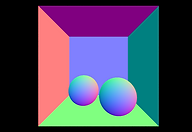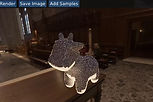Path Tracer: Implemented camera ray generation, ray-primitive intersection, and BVH that accelerats ray-scene intersection, along with path tracing, material shading, and direct and environment lighting.
Final Outcome

Materials: Mirror - perfect specular reflection (red shoe holder / table top) Refract - Snell's Law, BSDF attenuation using physical based rendering (shoe on the left) Glass - Schlick's approximation. Reflect + refract. (shoe on the right, blue shoe holder / table top) Lighting: Direct lighting - reduce variance by sampling light source directly. single-sample multiple importance sampling Lambertian BSDF and indirect lighting - simulate the complicated paths that light can take throughout the scene, bouncing off many surfaces before eventually reaching the camera (small shoe on the right) Environment lighting - uniformly sampling, then importance sampling the environment map (CDF and PDF) with Jacobian (room background)
Step by Step Learnings & Builds
Camera Rays
Implemented camera ray generation by transforming pixel coordinates into world-space rays using field of view, aspect ratio, and sensor size.



Intersecting Objects
Used Möller-Trumbore algorithm and Cramer’s rule for triangle intersection. The shading normal for a triangle is computed by linear interpolation from per-vertex normals using the barycentric coordinates of the hit point as their weights.
Bounding Volume Hierchy (BVH)
1. Bounding Box Calculation & Intersection
2. Surface Area Heuristic for BVH Construction
3. Ray-BVH Intersection using recursion



Global Illumination & Path Tracing
Implemented Lambertian BSDF, indirect and direct lighting estimation, and next-event estimation by splitting samples between BSDF scattering and area lights. Integrated mixture sampling and multiple-importance sampling to reduce variance, leveraging Monte Carlo estimation for accurate global illumination.
Materials & Specular Reflection/Refraction
Implemented mirror and glass materials using perfect specular reflection (via vector reflection) and refraction (via Snell’s Law), handling total internal reflection when necessary. Used Fresnel equations (or Schlick’s approximation) to determine reflection vs. transmission ratios for dielectric materials, enabling realistic light interactions through multiple-importance sampling in path tracing.

Environment Lighting & Importance Sampling
Lambert
Glass


Implemented environment lighting using HDR environment maps, first with uniform sampling and then with importance sampling to reduce variance. Built a probability distribution function (PDF) and cumulative distribution function (CDF) for efficient inversion sampling, accounting for pixel solid angles and brightness. Applied Jacobian correction to properly map environment map pixels to the unit sphere for accurate light sampling.
Fun Debuggings Before Success



